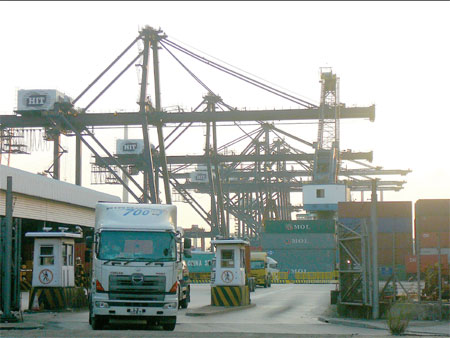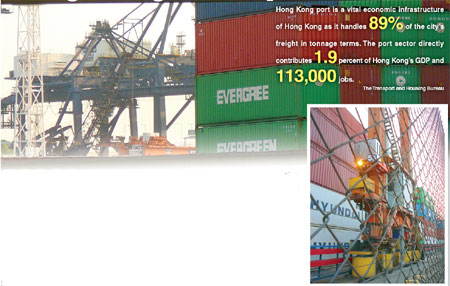Hong Kong: First port of call?
Updated: 2010-10-08 09:05
(HK Edition)
|
|||||||
|
Hong Kong port is a vital economic infrastructure of Hong Kong as it handles 89% of the city's freight in tonnage terms. The port sector directly contributes 1.9 percent of Hong Kong's GDP and 113,000 jobs. The Transport and Housing Bureau |

The city's status as an international container port faces challenges from Shanghai and Singapore. But it is neighboring Shenzhen that will determine whether Hong Kong remains relevant. Richard Macauley reports.
Hong Kong's container port is one of the first sights to greet newcomers to the city as they careen in taxis and buses from the airport to either Hong Kong Island or Kowloon. The yellow lights, looming cranes and endless rows of containers, stacked high and wide like giant matchboxes inspire a sense of wonder about the magnitude of goods created on the mainland, facilitated in Hong Kong, and enjoyed by the rest of the world.
For many people, Hong Kong's container port remains a symbol of the city's international importance, as well as a sign of its economic might. It is a sharp departure from the slick skyscrapers on Hong Kong Island which serves well as a symbol of the city's white collar wealth, but few who pass the port - one of the busiest in the world - will feel any less humbled by it.
When assessing just how much trade is conducted through the port, measurements are taken in "twenty-foot equivalent units" (TEUs). Each 20-foot container received or sent at the port counts as one TEU, and a 40-foot container counts as two TEUs.
Between 2000 and 2009, Hong Kong's total container throughput (the amount of TEUs handled) rose 16 percent, from 18.1 million TEUs to 21 million. Of this figure, the great majority was handled by Kwai Tsing Container Terminals - a vast industrial site that sits on the reclaimed Rambler Channel between Kwai Chung and Tsing Yi Island.
But these figures mask a sharp decline in relevance and, crucially, market share for Hong Kong as a gateway between the mainland and the rest of the world. During the same period, Hong Kong's market share of the goods imported and exported to and from southern China slumped from near dominance at 90 percent to just 20 percent.
Hong Kong has become stagnant in the past decade compared with Shanghai and Singapore - the two cities Hong Kong most associates itself with in its fight to be Asia's "world city". Both cities increased their throughput by 92 and 40 percent respectively. As a result Hong Kong has seen its title as the biggest export hub in the world slip to number three, behind its two longtime competitors.
Despite this apparent threat to its continued relevance, Alan Lee, chairman of the Hong Kong Container Terminal Operators Association (HKCTOA) points out that all eyes need to be focused not on its rivals but rather on a more local threat to the future of Hong Kong's role as a port city. "Singapore is not our biggest competitor," he says. "It is Shenzhen.
"In fact, when people ask me now, 'when will Shenzhen's overtake Hong Kong's container port?' I now tell them: 'It already has'."
Lee says that while the container port can be made to be more competitive in order to take on Shenzhen, the government and clients of the port agree that losing the edge against the city's mainland neighbor would indeed hurt the wider interests of Hong Kong.
The rise of Shenzhen's container port capacity has been rapid, and annual figures now nip at the heels of Hong Kong's total exports. In the month of July, Shenzhen's ports not only dealt with more traffic than Hong Kong's, but there is also further evidence to show that Hong Kong is even less competitive than it appears.
"Around half of the cargo that passes through Hong Kong is just vessel-to-vessel transfers," says Lee. A vessel-to-vessel transfer is one in which a container is brought to Hong Kong, shifted from one ship to another and then sent out again. "However, this container is counted twice: once on its way in to Hong Kong, and once on its way back out. How many actual containers are there in this transaction? One, but it will be recorded as two."
It means that around half of the containers counted at Hong Kong's container port have in fact been counted twice. Furthermore, when a 40-foot container is transferred in such a way then that one container will be counted four times. Once these "phantom" containers are taken out of Hong Kong's container figures, the port actually falls behind Shenzhen in terms of containers handled on an export or import basis.
The HKCTOA is aware of this issue and has called on the government to provide better-tailored solutions for the Kwai Tsing terminals. Namely, it has requested that the position of a standalone shipping minister should be created in order to take control of the port and ensure its competitiveness in the future.
The government indeed says that it is supportive of the port, issuing a statement arguing that the impact the port has on the wider economy is too great to lose.
"(Hong Kong port) is a vital economic infrastructure of Hong Kong - (it) handles 89 percent of (Hong Kong's) freight in tonnage terms (of the remaining cargo coming into or out of Hong Kong, 1 percent is by air and 10 percent by land)," says a spokesperson from the Transport and Housing Bureau. "The port sector directly contributes 1.9 percent of Hong Kong's GDP and ... 113,000 jobs."
Add to this figure the fact that the port is an integral part of the wider trading and logistics sector - an industry that accounts for a quarter of the city's entire GDP - and it is clear just how significant it could be if Hong Kong loses its edge.
A spokesperson for Hong Kong-based logistics company OOCL also says that, despite competition from neighboring Shenzhen, Hong Kong's container industry remains crucial to the city's economy, and to the city's relevance worldwide. "Hong Kong is an externally oriented economy, which has consistently adapted to changing times to move up the value chain and remains one of the world's most influential maritime hubs," says the spokesperson. "(Logistics functions) remain one of the four key pillars of the Hong Kong economy (and) logistics will remain an important pillar of the Hong Kong economy."
The importance of the port is well established, in the eyes of government, private industry and the city as a whole. But Lee explains that there are some recurring setbacks that port operators face in their attempts to make the container terminals more competitive.
"Firstly, Hong Kong container terminals don't have a lot of land compared with others elsewhere," says Lee. "An average container terminal will have around 25 hectares per berth for storing containers: Hong Kong has around half this space available." As such, Hong Kong container terminal users stack their containers higher and they require more machines to work faster - all of which add costs to Hong Kong operators and make the port less attractive compared with neighboring Shenzhen.
Space crunch in Hong Kong causing problems remains a familiar story, but Lee says that land which could be used for extra container storage space is often sold at auction to property developers. These developers do build warehouses for the logistics industry but their high bid prices mean high rents for container terminal operators. If conditions could be put in place to allow operators of the port a better shot at buying the land themselves, Lee says, they could then increase the competitiveness of Hong Kong's port by keeping costs low.
This is a sentiment well understood by logistics companies themselves. "(We) encourage more terminal capacity being built in Hong Kong," OOCL's spokesperson says. "We think there should be more capacity to enable Hong Kong to stay competitive in the logistics business."
In addition to the indirect costs involved with land however, there are also added direct costs for exporters hoping to use Hong Kong's port. There is also the problem of the border between the mainland and Hong Kong.
Hong Kong and Shenzhen are in competition to handle the goods manufactured in southern China (this is one of the reasons Lee maintains that he is unconcerned about how successful Singapore - which handles goods manufactured in Southeast Asia - appears to be). But faced with the choice of shipping via either Shenzhen or Hong Kong a typical business making goods in Dongguan, for instance, faces a fee of $200 per container if it chooses Hong Kong: a fee not payable if they choose to use Shenzhen.
"When Chinese trucks reach the border, the container they are transporting must be put onto a right-wheel drive truck suitable for Hong Kong roads," says Lee. "This means two separate trucks need to be organized, and even two separate drivers - one for the mainland and one for Hong Kong."
Not only is the company paying extra wage fees and truck costs , but it also slows the entire delivery process down somewhat. It leads to fewer deliveries per driver per day when compared to the number of trips that could be made if only travelling to Shenzhen ports, and so creates another reason to favor Shenzhen over Hong Kong.
However, the government has said that the high frequency of sailings and the ability to reach more than 500 destinations worldwide should ensure Hong Kong's competitiveness against Shenzhen. "Hong Kong port provides comprehensive, efficient and reliable port services, particularly as a (vessel-to-vessel) hub," said a government spokesperson.
Lee, however, points to a different scenario: "Hong Kong could continue to expand (in container terms) but without earning market share back from Shenzhen we would still be losing the battle for competitiveness," he says.
Taking a walk to the container port terminals at Kwai Chung is an ear-splitting experience. Trucks roar past almost every second, carrying 20- or 40-foot containers stuffed with goods created in China and destined for any country in the world. Standing in front of the port, it would be easy to convince anyone that this is still the busiest container port in the world, and it is indeed difficult to imagine from that spot that it will fade in significance.
But it has been rapidly losing market share to Shenzhen, and faces tougher hurdles for expansion than its mainland neighbour.
"Pearl River Delta ports have a competitive edge in terms of cost and land whereas Hong Kong port, being a free port with simple and efficient customs clearance and higher frequency of shipping schedule, commands niches," adds the government's spokesperson.
Many eyes will be watching whether this will be enough for Hong Kong to remain as crucial to the rest of the world as it has in the past.
(HK Edition 10/08/2010 page4)
